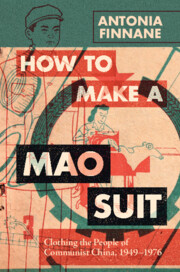Book contents
- How to Make a Mao Suit
- Cambridge Studies in the History of the People’s Republic of China
- How to Make a Mao Suit
- Copyright page
- Dedication
- Epigraph
- Contents
- Figures
- Maps
- Tables
- Acknowledgements
- Technical Notes and Key Dates
- Introduction
- 1 The Red Group Tailors and the Zhongshan Suit
- 2 Notions and Sewing Tools
- 3 Making Zhifu
- 4 Sewing Like a Girl
- 5 Rationing
- 6 The Time of the Sewing Machine
- 7 Pattern Books I
- 8 Pattern Books II
- 9 What Should Chinese Women Wear?
- Conclusion
- Book part
- Glossary
- References
- Index
6 - The Time of the Sewing Machine
Published online by Cambridge University Press: 20 July 2023
- How to Make a Mao Suit
- Cambridge Studies in the History of the People’s Republic of China
- How to Make a Mao Suit
- Copyright page
- Dedication
- Epigraph
- Contents
- Figures
- Maps
- Tables
- Acknowledgements
- Technical Notes and Key Dates
- Introduction
- 1 The Red Group Tailors and the Zhongshan Suit
- 2 Notions and Sewing Tools
- 3 Making Zhifu
- 4 Sewing Like a Girl
- 5 Rationing
- 6 The Time of the Sewing Machine
- 7 Pattern Books I
- 8 Pattern Books II
- 9 What Should Chinese Women Wear?
- Conclusion
- Book part
- Glossary
- References
- Index
Summary
Chapter 6 makes a case for periodizing the Mao years as the time of the sewing machine and homemade clothing. Before 1949 most sewing machines were imported. After 1949 a sewing-machine industry developed rapidly and within the space of fifteen years there were factories in practically every province. In propaganda, the sewing machine is overshadowed by the gun, the hammer and the sickle. There were no public awards for the heroic task of working the whole night through to clothe the family. It was possible for a woman to be employed in a clothing factory in the day and then to be fully occupied making clothes at night. Personal memoirs and biographical accounts suggest efforts on an extraordinary scale by individual women in providing clothes for family members and neighbours. They made for love, for necessity, for social advantage and for money. For people who grew up in those decades, the sound of the sewing machine is a clear childhood memory, inextricably linked with memories of the clothes their mothers made them.
- Type
- Chapter
- Information
- How to Make a Mao SuitClothing the People of Communist China, 1949–1976, pp. 162 - 193Publisher: Cambridge University PressPrint publication year: 2023

